Create a Menu item that points to the URL: http://www.yoursite.com/wp-login.php?action=register
Create Virtual Directory for an application in Enkompass
Many need the ability to create a Virtual Directory in IIS that will be persistant with the config pushes that Enkompass does. This will be easy to accomplish when 2.2 releases but in the interim we have worked on a method to do this via the PostgreSQL backend database. Please make sure you have a backup and use extreme caution when editing the PG database as it is a critical component of Enkompass.
Figure 1 & 2: Launch PG3Admin to log into Postgresql
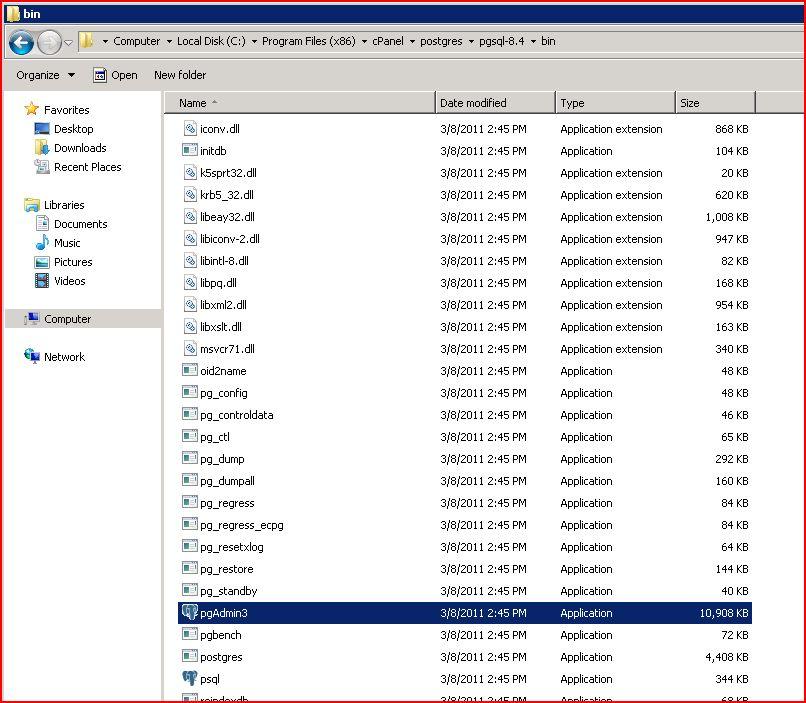
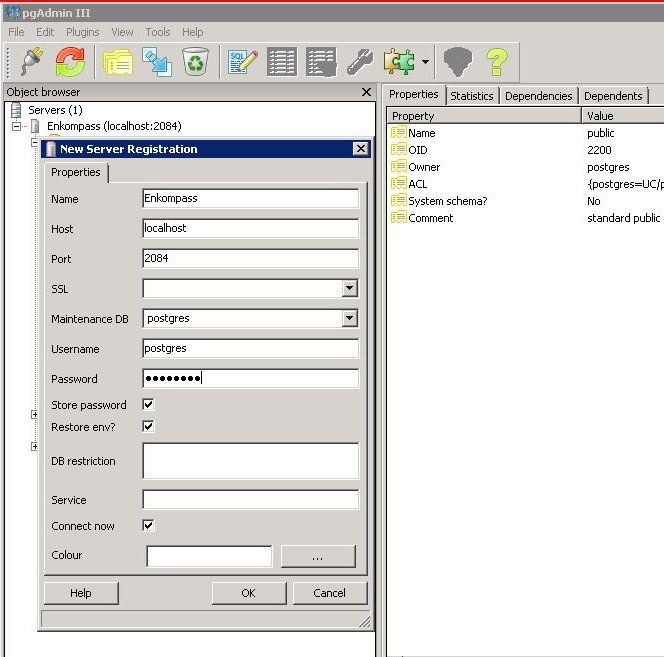
Figure 3 & 4: Drill down through Databases, apphostconfig, Schema, Public, Tables and find the Sites table. Use View Top 100 Rows from the View Data sub menu for each table example in this tutorial.
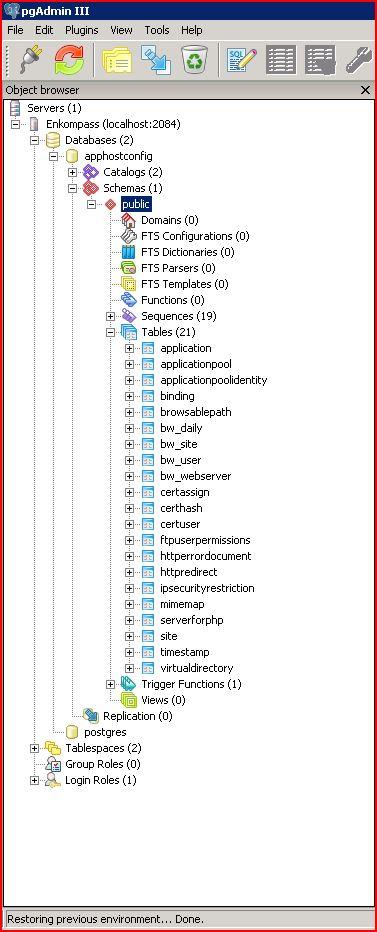
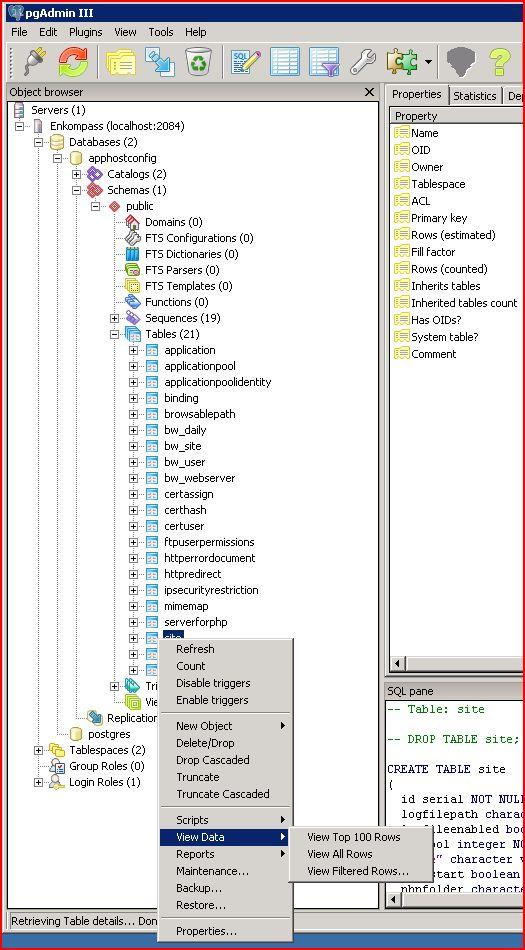
Figure 5: Get the id [PK] integer for the site you wish to create the virtual directory and application for. I am using my todd.tld domain as an example and therefore need the id[PK] integer 1. You can close this table view when you have the value.

Figure 6: Go to the application table and at the bottom on a new line add the name of the subdirectory to the second column (path character varying) and the id from Sites to the third column (site integer). In my case I needed the subdirectory of /newapp and it was for site 1 so that is what I put in the respective columns.
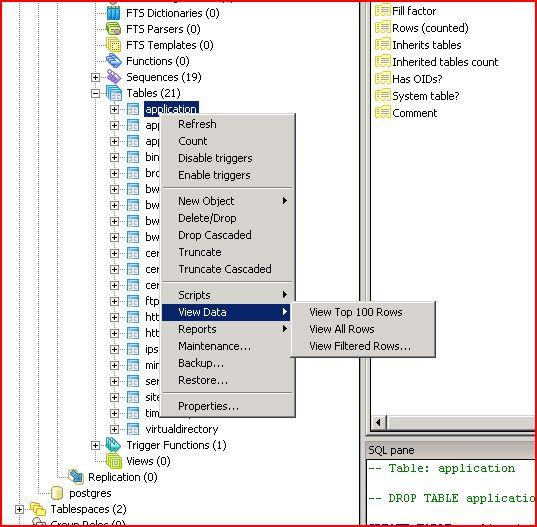
Figure 7: Once you save a value will be generated for the first column; refresh and get that number for the next step. The id [PK] integer in this table, 17 is what I will need for the next step.
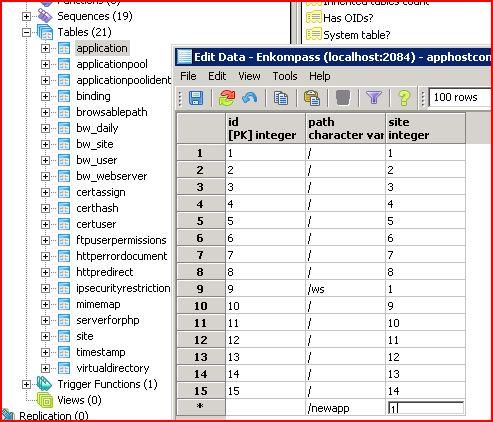
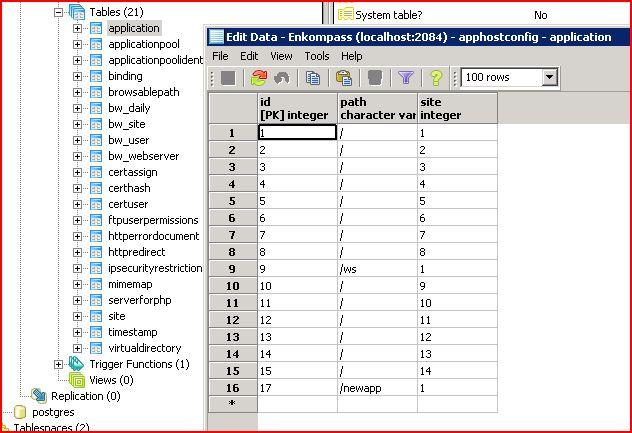
Figure 8: Now go to the virtualdirectory table: Again, scroll to the bottom for a new line to be visible and in the second Column 2 (application integer) you will enter the value generated after saving/refreshing from column 1 (id [PK] interger from the previous step) In my case this was 17. In Column 3 (virtualpath character varying) you will add a /, and in Column 4 (physicalpath character varying) you will add the full path to the folder. In my case it is c:UserscPaneltoddpublic_htmlnewapp.
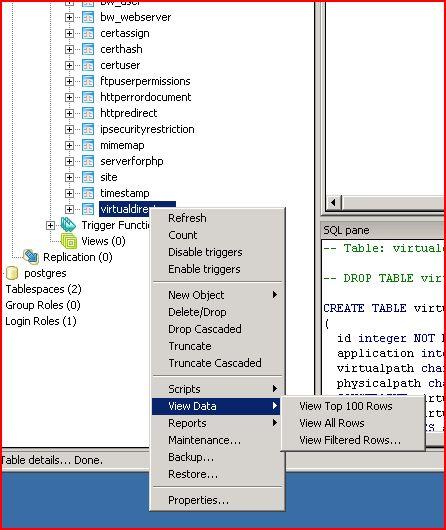
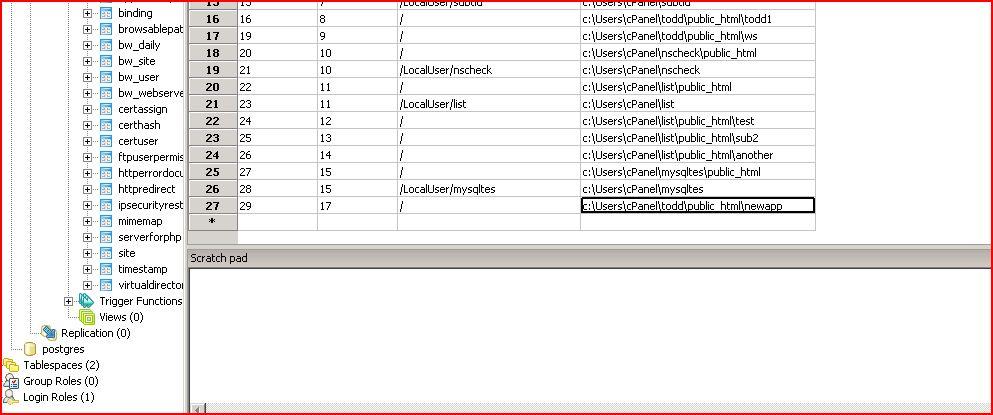
Figure 9: Once you save, you can trigger a configuration push or wait for the scheduled configuration re-publish. If the application is already setup in c:UserscPaneltoddpublic_htmlnewapp then it should start working immediately.
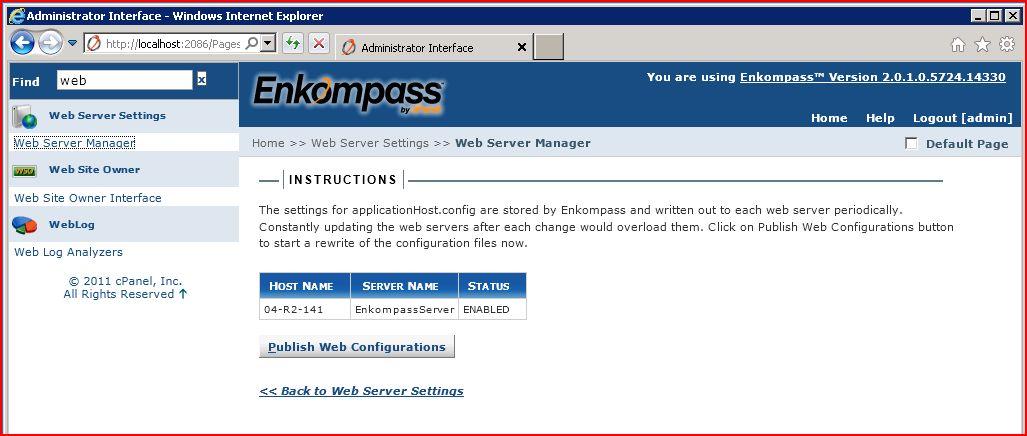
Understanding Windows Server 2008 Active Directory Domain and Forest Functional Levels
In Windows Server 2003, functional levels were an extension of the older mixed/native mode concept introduced in Windows 2000. In Windows Server 2008 this was further extended to include new features and benefits, and are used to activate new Active Directory features after all the Domain Controllers (DCs) in the domain or forest are running Windows Server 2008 operating systems. Functional levels determine the features of Active Directory Domain Services (AD DS) that are enabled in a domain or forest.
When the first Windows Server 2008–based Domain Controller is deployed in a domain or forest, the domain or forest operates by default at the lowest functional level that is possible in that environment, meaning Windows 2000 Native Mode. This allows you to take advantage of the default Active Directory features while running versions of Windows earlier than Windows Server 2008. When you raise the functional level of a domain or forest, a set of advanced features becomes available.
After the domain functional level is raised, DCs that are running earlier operating systems cannot be introduced into the domain. For example, if you raise the domain functional level to Windows Server 2008, Domain Controllers that are running Windows Server 2003 cannot be added to that domain.
Unless you still have old NT 4.0 BDCs there’s no reason for staying in Mixed Mode, and as you already know, Windows Server 2008 does not support NT 4.0 BDCs, so if you are still using them and planning to upgrade your Active Directory to Windows Server 2008, re-think your strategy.
As for Windows 2000 Native Mode, unless you still have Windows 2000 Domain Controllers, again, there’s no reason for staying in that function level. However, if you still do, remember that Windows Server 2008 does only supports Windows 2000 SP4. Be sure to have SP4 on all your Windows 2000 DCs.
Note: Network clients can authenticate or access resources in the domain or forest without being affected by the Windows Server 2003 or Windows Server 2008 domain or forest functional levels. These levels only affect the way that domain controllers interact with each other. However, be aware of the fact that regardless of the domain or function level, servers running Windows NT Server 4.0 are NOT supported by domain controllers that are running Windows Server 2008, meaning you MUST have additional DCs running Windows 2000/2003 to support older NT 4.0 servers.
Domain Function Levels
To activate a new domain function level, all DCs in the domain must be running the right operating system. After this requirement is met, the administrator can raise the domain functional level. Here’s a list of the available domain function levels available in Windows Server 2008:
Windows 2000 Native Mode
This is the default function level for new Windows Server 2008 Active Directory domains.
Supported Domain controllers – Windows 2000, Windows Server 2003, Windows Server 2008.
Features and benefits:
- Group nesting – Unlike Windows NT 4.0, allows placing of a group of one scope as a member of another group of the same scope.
- Universal security groups – Allows usage of Universal security type groups.
- SidHistory – Enables usage of SidHistory when migrating objects between domains.
- Converting groups between security groups and distribution groups – Unlike Windows NT 4.0, allows converting of a group type into another group type (with some limitations).
Windows Server 2003 Mode
To activate the new domain features, all domain controllers in the domain must be running Windows Server 2003. After this requirement is met, the administrator can raise the domain functional level to Windows Server 2003.
Supported Domain controllers – Windows Server 2003, Windows Server 2008.
Features and benefits include all default Active Directory features, all features from the Windows 2000 native domain functional level, plus:
- Universal group caching – Windows Server 2003 functional level supports Universal group caching which eliminate the need for local global catalog server.
- Domain Controller rename – By using the NETDOM command.
- Logon time stamp update – The lastLogonTimestamp attribute will be updated with the last logon time of the user or computer. This attribute is replicated within the domain.
- Multivalued attribute replication improvements – Allows incremental membership changes, which in turn enables having more than 5000 members in a group and better replication capabilities.
- Lingering objects (zombies) detection – Windows Server 2003 has the ability to detect zombies, or lingering objects.
- AD-integrated DNS zones in application partitions – This allows storing of DNS data in AD application partition for more efficient replication.
- Users and Computers containers can be redirected – This allows the redirection of the default location of new users and computers (by using the REDIRUSR and REDIRCMP commands).
- Support for selective authentication – Makes it possible to specify the users and groups from a trusted forest who are allowed to authenticate to resource servers in a trusting forest.
Windows Server 2008 Mode
To activate the new domain features, all domain controllers in the domain must be running Windows Server 2008. After this requirement is met, the administrator can raise the domain functional level to Windows Server 2008.
| Important |
| Raising the domain and forest functional levels to Windows Server 2008 is a nonreversible task and prohibits the addition of Windows 2000–based or Windows Server 2003–based Domain Controllers to the environment. Any existing Windows 2000–based or Windows Server 2003–based Domain Controllers in the environment will no longer function, and in fact, the upgrading wizard will not allow you to continue with the operation. Before raising functional levels to take advantage of advanced Windows Server 2008 features, ensure that you will never need to install domain controllers running Windows 2000-based or Windows Server 2003–based Domain Controllers in your environment. |
Supported Domain controllers – Windows Server 2008.
Features and benefits include all default Active Directory features, all features from the Windows Server 2003 domain functional level, plus:
- Fine-grained password policies – Allows multiple password polices to be applied to different users in the same domain.
- Read-Only Domain Controllers – Allows implementation of domain controllers that only host read-only copy of NTDS database.
- Advanced Encryption Services – (AES 128 and 256) support for the Kerberos protocol.
- Granular auditing – Allows history of object changes in Active Directory.
- Distributed File System Replication (DFSR) – Allows SYSVOL to replicate using DFSR instead of older File Replication Service (FRS). It provides more robust and detailed replication of SYSVOL contents.
- Last Interactive Logon Information – Displays the time of the last successful interactive logon for a user, from what workstation, and the number of failed logon attempts since the last logon.
Forest function levels
Forest functionality activates features across all the domains in your forest. To activate a new forest function level, all the domain in the forest must be running the right operating system and be set to the right domain function level. After this requirement is met, the administrator can raise the forest functional level. Here’s a list of the available forest function levels available in Windows Server 2008:
Windows 2000 forest function level
This is the default setting for new Windows Server 2008 Active Directory forests.
Supported Domain controllers in all domains in the forest – Windows 2000, Windows Server 2003, Windows Server 2008.
Windows Server 2003 forest function level
To activate new forest-wide features, all domain controllers in the forest must be running Windows Server 2003.
Supported Domain controllers in all domains in the forest – Windows Server 2003, Windows Server 2008.
Features and benefits include all default Active Directory features, plus the following features:
- Forest trust.
- Domain rename.
- Linked-value replication – Changes in group membership to store and replicate values for individual members instead of replicating the entire membership as a single unit.
- Deployment of an RODC.
- Intersite topology generator (ISTG) improvements – Supports a more efficient ISTG algorithm allows support for extremely large numbers of sites.
- The ability to create instances of the dynamicObject dynamic auxiliary class.
- The ability to convert an inetOrgPerson object instance into a User object instance, and the reverse.
- The ability to create instances of the new group types, called application basic groups and Lightweight Directory Access Protocol (LDAP) query groups, to support role-based authorization.
- Deactivation and redefinition of attributes and classes in the schema.
Windows Server 2008 forest function level
To activate new forest-wide features, all domain controllers in the forest must be running Windows Server 2008.
Supported Domain controllers in all domains in the forest – Windows Server 2008.
Features and benefits include all of the features that are available at the Windows Server 2003 forest functional level, but no additional features. All domains that are subsequently added to the forest will operate at the Windows Server 2008 domain functional level by default.
How to run a CGI program under IIS 7.0 or IIS 7.5
Looking around I didn’t find a good documentation on how to get good old CGI’s running on IIS 7 or 7.5. Here is a quick walkthrough:
1. Let’s write a quick CGI: Take the following code and save it as simplecgi.cs in the directory c:inetpubwwwrootcgi
using System; using System.Collections;
class SimpleCGI { static void Main(string[] args) { Console.WriteLine("rnrn"); Console.WriteLine("<h1>Environment Variables</h1>"); foreach (DictionaryEntry var in Environment.GetEnvironmentVariables()) Console.WriteLine("<hr><b>{0}</b>: {1}", var.Key, var.Value); } }
2. Change into the C:inetpubwwwrootcgi directory and compile the source by using the following command-line:
%windir%Microsoft.NETFrameworkv2.0.50727csc.exe SimpleCGI.cs
You will have simplecgi.exe in the cgi directory. You can execute it on the command-line to see its output.
3. For security reasons every CGI has to be registered in the ISAPI/CGI Restriction list. To do that you have to open INETMGR, click the machine node (name of your machine) and find the ISAPI/CGI Restriction List menu icon.
Select the item and add the following entries in the dialog box:
Alternatively you can use the command-line:
%windir%system32inetsrvappcmd set config -section:isapiCgiRestriction /+[path='c:inetpubwwwrootcgisimplecgi.exe',allowed='true',description='SimpleCGI']
4. The next step is to create a virtual directory that allows CGIs to execute. Right click the “Default Web Site” in INETMGR and select “Add Virtual Directory”. Add the following entries:
Here is the command-line which does the same:
appcmd add vdir /app.name:"Default Web Site/" /path:/cgi /physicalPath:"c:inetpubwwwrootcgi"
5. One last step: we still don’t allow “Execute” access in this directory. For this you have to go to the Handler Mappings menu of the CGI virtual directory (make sure you select the CGI virtual directory on the left hand side!).
Go to the “Edit Feature Permissions” link in the Actions Menu on the right hand side, open it and check “Execute” and click “OK”.
via command-line:
appcmd set config "Default Web Site/cgi" /section:handlers -accessPolicy:"Read,Script,Execute"
Now you are ready to go. Type “http://localhost/cgi/simplecgi.exe and you should see the following output:
A very nice MySQL client…for FREE!
I have tried so many MySQL clients both paid and not paid, and I found that HeidiSQL is an awesome client for Windows desktops to connect to MySQL.
Please check out thier site at: http://www.heidisql.com/





